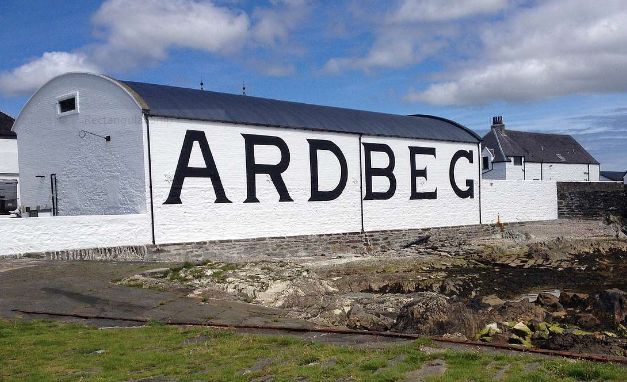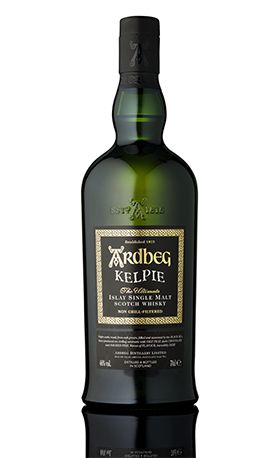
The Ardbeg Distillery on Islay
Whisky marketing has changed dramatically over the last several decades. Gone is the imagery of tartan-clad pipers heralding a new Scotch whisky release or evoking the Scottish roots and character of Scotland’s best-known export. Instead distillers have striven to create a unique character for their iconic brands, ranging in breadth from high-end sophistication to hip bad boy. The bad boy image has proven to be particularly popular on Islay, whose brawny, powerful, peated whiskies, redolent of tar and smoke and the sea, have led some distillers to portray themselves as the Scotch whisky’s equivalent of Easy Rider.
At the same time, distilleries have reached out to the fans and customers to encourage loyalty and create ties that bind. Elaborate visitor centers are increasingly mandatory at distilleries, complete with restaurant/cafes, gift shops, branded clothing and accessories, and on premise museums. Clubs, newsletters and fan organizations are essential. Dedicated websites and the obligatory Twitter feed, Facebook page and YouTube channel, more reminiscent of a teenage pop star than an industrial company, are now the norm.
Considering that a distillery is little more than a cross between a refiner and a chemical plant, it’s hard to imagine it would become an object of worldwide devotion, that legions of fans would feel compelled to undertake pilgrimages to the fountain head of their favorite whiskies, or that some fans would go as far as to have their favorite whisky’s logos permanently tattooed on their body.
No whisky distillery has been more successful in fostering and embracing its “bad boy” image, while at the same time creating legions of loyal fans around the world, than the Ardbeg Distillery. Its powerful, peated whiskies seem the quintessential, bad boy rebel to the conventional, “establishment whiskies” of Speyside and the Lowlands. If Macallan, Glenlivet and Glenfiddich are Scotch’s equivalent of the cheerleader squad or king and queen of the prom, then Ardbeg is the black leather jacket clad greaser who rides a motorcycle to school and cuts class to grab a smoke behind the gym. In other words, if Speyside is cool, suave, sophisticated George Clooney, then Ardbeg is Shia LaBeouf.
The Ardbeg distillery recommenced operations in 1997, after an extended period of intermittent shutdowns that saw the facility completely mothballed from 1981 through 1989, and having only limited production from 1989 through 1996. The distillery was purchased by Glenmorangie in 1997, and they in turn were bought by the French fashion and spirits conglomerate LVMH in 2004.
At the end of 1999, shortly after its relaunch, Ardbeg organized “The Committee,” its umbrella organization for its worldwide fans. Officially, it was founded on the first day of the new millennium. According to Ardbeg lore, the name came from the fact that tiny Islay, with a population of only about 3,000 people, had 120 different committees. From the onset, the purpose of “The Committee” was clear— “members are expected to actively pursue a serious and altruistic duty: to bring others into the Ardbeg fold. The result of the collective effect of this is to increase worldwide consumption, thereby ensuring that the doors of Ardbeg shall never close again.”
The Committee had 3,500 members in 2000. Membership steadily grew. By 2003 it had reached over 18,000 members in 81 countries and by 2016 it exceeded 120,000 members in 140 countries. Committee members get their own exclusive newsletter “Momentous Minutes,” and Ardbeg even organized a “Club Room” at the distillery for these ardent fans.
From a practical standpoint, the distillery has used The Committee in a dual role. First, it is a perfect sales channel for Limited Edition bottlings of Ardbeg expressions whose underlying stock is too small for a sustained worldwide release. This includes inventory that was inherited when Glenmorangie bought the distillery, like the famous, mostly unpeated Ardbeg that was bottled as Kildalton in 2014. In total, there have been around two dozen Limited Edition releases.
In addition, Ardbeg used Committee members as a useful sounding board to test new expressions. A 120,000-member focus group may appear a bit daunting, but Committee members are anxious to share their impressions of prospective Ardbeg releases. Ardbeg Corryvreckan began as Limited Edition Committee releases and eventually became part of the core range. Ardbeg’s devotees are so fanatical that The Committee versions of an expression often sell on secondary markets at substantial premiums to the regular release versions of those expressions, even when they are essentially very similar whiskies.

100 Foot Tall Statutes of mythical kelpies at Falkirk, Scotland
The most recent Limited Edition bottling released by The Committee is Ardbeg Kelpie. The whisky is named for a mythical creature that inhabits the lochs and bays of Scotland. The kelpie, also known as the water kelpie, is a shapeshifting water-spirit. It typically appears as a beautiful black horse and on rare occasions as a bull, but is said to be able to take human form, although its hooves remain when it does so. On occasion, kelpies would drag their innocent riders to their deaths in a watery grave. A kelpie is rumored to inhabit a whirlpool in the Strait of Corryvreckan that separates the islands of Jura and Scarba. J.K. Rowling used the legend of the kelpie in her Harry Potter books to describe “a shapeshifting water demon that was native to Great Britain and Ireland.” The legend of the Loch Ness monster also draws heavily on folklore accounts of kelpies.
The Committee version of Ardbeg Kelpie was released on March 16. It was bottled at 51.7% ABV and was only available to members of the distillery’s worldwide fan club. The regular version was released on June 3, the distiller’s annual Ardbeg Day, at a 46% ABV. Ardbeg Day is part of the annual Islay Festival of Malt and Music; Feis Ile in Gaelic. The last Saturday of the festival has traditionally been designated Ardbeg Day, and the distillery has used the occasion to create a worldwide celebration “of all things Ardbeg.” It was reserved exclusively for Ardbeg Embassy retailers until June 17.
According to the distillery, Ardbeg Kelpie is the first expression to be matured, in part, in virgin casks of Black Sea oak. The oak is from the Adyghe Republic in Russia, a region between the Black Sea and the Sea of Azov in the west and the Caspian Sea in the east. Adyghe is an independent republic within Russia. It is surrounded by Krasnodar Krai, another republic within the Russian state.
This area hosts the Russian Space Launch facility at Krasnodar, and is also the home of the legendary Kuban Cossacks. The casks were chosen by Dr. Bill Lumsden, Ardbeg’s Director of Distilling, Whisky Creation and Whisky Stocks, because of the intensity and “depth of flavor they impart.” Lumsden has been a leader in the Scotch whisky industry in studying different varieties of white oak and testing their suitability for maturing malt whisky. Ardbeg Kelpie is a blend of malts that were matured in traditional ex-bourbon casks and Black Sea oak casks.
To be clear, Black Sea oak is not a specific variety of oak. It is a generic term for the oaks that grow in the Black Sea region. Among the principal oak varieties found here are the Sessile oak (Quercus polycarpa), the Hungarian oak (Quercus frainetto) and the Turkey Oak (Quercus cerris). Sessile oak is also known as Quercus petraea, one of the principal oaks found in the oak forests of France, and is extensively used in barrel making. Along the eastern flank of the Black Sea, Quercus petraea grows slowly producing a particularly dense, fine grained wood. Barrels made from this oak species have long been used by wine makers from Bulgaria to Georgia and Armenia. This wood is known for imparting an intense spicy character. Although the distillery did not specify the actual variety of oak used, it is most likely Quercus petraea.

The Committee’s Limited Edition release of Ardbeg Kelpie
Ardbeg Kelpie, Committee Edition, No Age Statement, 51.7% ABV, 700 ml
Kelpie has a rich gold color. On the nose there is peat smoke, char and elements of tar and creosote. There are pronounced cereal notes along with the phenolic and marine elements of iodine, seaweed, oily smoked fish and the jetsam and flotsam of a rocky beach at low tide. There are citric notes of lemon in the background.
On the palate, there is an oily viscous, resinous mouth feel and weight. There is a distinctive sweet note of caramel that gives way to a dry, almost licorice like, herbal note that grows progressively bitter and savory with a slight peppery note in the end. The smoke is pervasive but nuanced, hanging in the background but less pronounced on the palate than it was on the nose. There is wood spice in the background as well, hints of vanilla and cinnamon. The addition of a little water emphasizes the licorice/anise quality and the lingering sweetness that accompanies it.
The finish is long and nuanced. There is lingering smoke, sweetness, licorice and anise that gradually gives way to a peppery, slightly woody, bitterness.
This is an excellent whisky, complex, nuanced and balanced. The oiliness is a bit more pronounced than in other Ardbeg expressions, (think Corryvreckan +) and is reminiscent of Lagavulin. It would be interesting to know whether the distillery used the same cut points that it uses on its other expressions or if the oiliness is an attribute of the Black Sea oak barrel wood. The finish is excellent—smoke lingers across the finish, framed nicely by a sweetness that gradually gives way to a slight, peppery bitterness.
Appearance: 9/10, Nose: 28/30, Palate: 26/30, Finish: 27/30. Overall Score 90/100
